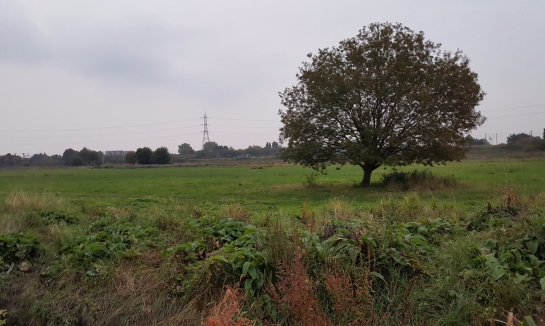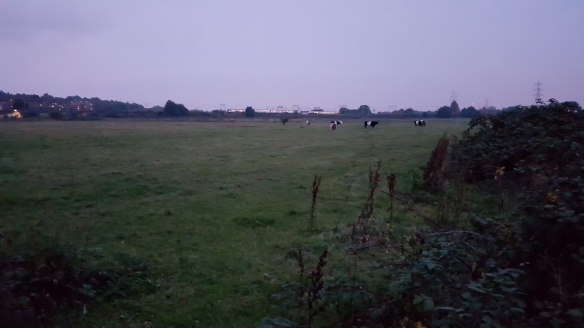A footballer, arriving early to Hackney Marsh one autumn Sunday League morning, sees strange lights flicker in the mist.
A conservationist, picking through trees at the edge of Walthamstow Marshes on a quiet afternoon, hears shouting and laughter from the adjacent field. When he emerges from the overgrowth, he finds the field is empty.
A commuter, on a train crossing the marshes one dark winter evening, thinks she sees a ramshackle settlement of odd-looking houses where she knows only scrubland should be. She puts a hand to the glass to block the reflection from the carriage lights, but the train moves on, and the vision fades into the night.
Most people would soon forget such moments – once an eerie, out of place feeling had passed. But for some residents of the streets surrounding North East London’s Lea River Marshes, the feeling might linger. It might nag at them, in the days and nights to follow, until finally an old tale from their school days surfaced in their memory. Then, they may wonder if they have played a small part in the strange, restless life of a most unusual portal: a temporally and geographically untethered market town named Elswick-on-the-Marsh.

Even for the tiny number of locals who remember it, Elswick (pronounced Ezzik or Elzik, depending on who you’re speaking to) is notoriously elusive. Glimmers, glimpses in the half-light, unexplained voices, distant shadows: these are the ways in which Elswick manifests.
Unless you are one of the privileged few.
We learned about Elswick from Jessica, a teenager from Leyton. She, in her turn, had learned about the village from her Great Aunt (whom Jessica calls ‘Nan’).
“I don’t remember a time when those stories weren’t in my head”, Jessica told us. “Of people who had found Elswick and never returned. When Nan told them to me, her eyes would get this look. The way she used to talk about it, I never knew whether it was a good or a bad place. All I knew was that she was obsessed”.

Jessica says she carries in her memory a small book’s worth of Nan’s sayings about Elswick. “She’d repeat them like prayers… ‘Elswick is a doorway’ … ‘Elswick ever moves’ … ‘Elswick shows itself for a reason'”.
Nan walked the marshes almost daily, often taking Jessica with her.
“Look for a path, Nan said. An old paved road you haven’t seen before. And – how did she used to put it? – ‘Don’t take the path unless you’ve got something to trade'”.
Now, Jessica searches for Elswick alone. Nan went missing five years ago, when Jessica was not long into secondary school.
Jessica is pretty certain she knows where her aunt went.

Much has been written about the marshes surrounding the River Lea, a tributary to the Thames. They have been drained since Medieval times and up until the 19th century were mainly lammas (common agricultural) land, used by commoners for grazing cattle and growing wheat.
The extent of the marshes, while still impressively large and wild-seeming for an area so close to London’s centre, has diminished significantly since the industrial revolution. Railways, housing, industry, waterworks, international sporting events – the enemies of the open marshland are many, and the struggle to protect what remains is ongoing.
When it comes to Elswick, the written records are much more sketchy. In fact, we found only one concrete mention, albeit from a major source. The Domesday book records the small settlement of Elleswych, in the Hundred of Beconsfield, Essex, under Lord Peter of Velognes.
We knew it was a long shot, but with the written records less than helpful, we decided we had to visit the Marshes for ourselves. We went close to dusk, knowing that most sightings occur in the still-time between night and day.

The path that Jessica mentioned was our starting point. We can presume that when the Domesday survey was made, Elleswych enjoyed a relative degree of stability within space and time. So on which road did it lie in the 11th Century?
There are references to a paved Roman road that crossed the marshes near Leyton, but its location, if it exists at all, is disputed. There is of course the old road which crosses the River Lea at Stratford, but there is little remaining of the marshes there. We weren’t sure where to look next.
Then we read about the Black Path.
The Black Path was a porter’s way, leading from the fields to the great market of London (Lundenburh, as it was in the late Anglo-Saxon period). It was also a route of pilgrimage. Both uses seemed to chime with what we knew about Elswick.
You can follow the Black Path’s line on modern maps – look for a straight diagonal through London Fields up to Hackney City Hall which becomes, a few lost turnings later, Porchester Road in Clapton. After the marshes you can pick it up again in Walthamstow, near St James’ Park. But the path’s way across Leyton Marsh has been lost. Some open space remains here, however, so that is where we headed.

From here we explored east and north, along the line of the Lea and inland, into Walthamstow Marshes. As twilight deepened and shadows rose from the brambles and bullrush, from the grassland and scrub, certain lights became apparent at the marsh’s edge. Half-hidden industrial buildings, streetlamps, the headlights of a distant train. Glimpsed in the gloaming, you can see how they could be mistaken for the lost village.
Sounds, too, drift across the marshes. Unexplained noises weave with crow-caws and the rattle of the passing trains. A pylon buzzes overhead, briefly harmonising with the airborne, ever-present roar of the city.
Are the stories just phantoms? Is Elswick an unreachable will-o-the-wisp?

But we remember Jessica’s fervent words.
“It’s out there somewhere, the old trading post. Nan certainly had a lot to trade. So much to give… She once said Elswick only revealed itself to those in need of it. Or those whom it needed”.
Did Nan need it?
“I don’t know. It was around the time of the Olympics that Nan disappeared. She took a lot of that whole thing badly. The loss of great chunks of the marshes. She knew friends that relied on a lot of the community stuff that was lost, the allotments and all that. But – I was only a child. I can’t believe that Nan would have left me by choice”.
We feel bad for Jessica and her unanswered questions, tied up as they are with this fickle, endlessly flittering gateway – and with the uncertain future of a unique and magical part of London.
- Candidate: Elswick-on-the-Marsh
- Type: Temporal Untethering
- Status: Active [monitored]

Sounds like a lot of folk tails of fairy roads
LikeLiked by 1 person
Hi.
An interesting article. I lived in Mandeville Street as a kid and spent many long hours wandering through the marshes. And the area does seem to exude a sensation of otherness.
I personally witnessed several UFOs and on one occasion came across the carcasses of several large animals out on the marsh. (Just beyond the low bridge at the end of Coppermill Lane.)
These were reported in the local newspaper as being the remains of large cats. Unfortunately I no longer have the press cutting but I’m hoping to get another from a news archive.
A bizarre story but true. Goodness knows what it means. Perhaps science will one day advance to the point of understanding these odd things.
LikeLike